Directional Elastic Pseudospin and Nonseparability of Directional and Spatial Degrees of Freedom in Parallel Arrays of Coupled Waveguides
Abstract
1. Introduction
2. Materials and Methods
2.1. Fabrication of the Samples
2.2. Experimental Fixtures and Procedures
3. Experimental Results
3.1. Single Rod Acoustic Waveguide,
3.2. Coupled Two-Rod Waveguides,
3.3. Coupled Three-Rod Waveguides,
4. Numerical Modeling: Mass-Spring Waveguides
4.1. Single Chain Mass-Spring Waveguides
4.2. Coupled Two-Chain Mass-Spring Waveguides
4.3. Coupled Three-chain Mass-Spring Waveguides
5. Discussion and Concluding Remarks
Supplementary Materials
Author Contributions
Funding
Conflicts of Interest
References
- Horodecki, R.; Horodecki, P.; Horodecki, M.; Horodecki, K. Quantum entanglement. Rev. Mod. Phys. 2009, 81, 865–942. [Google Scholar] [CrossRef]
- Bell, J.S. On the Einstein Podolsky Rosen paradox. Phys. Phys. Fiz. 1964, 1, 195–200. [Google Scholar] [CrossRef]
- Spreeuw, R.J.C. A Classical Analogy of Entanglement. Found. Phys. 1998, 28, 361–374. [Google Scholar] [CrossRef]
- Ghose, P.; Mukherjee, A. Entanglement in Classical Optics. Rev. Theor. Sci. 2014, 2, 274–288. [Google Scholar] [CrossRef]
- Töppel, F.; Aiello, A.; Marquardt, C.; Giacobino, E.; Leuchs, G. Classical entanglement in polarization metrology. New J. Phys. 2014, 16, 073019. [Google Scholar] [CrossRef]
- Karimi, E.; Boyd, R.W. Classical entanglement. Science 2015, 350, 1172–1173. [Google Scholar] [CrossRef]
- Aiello, A.; Töppel, F.; Marquardt, C.; Giacobino, E.; Leuchs, G. Quantum-like nonseparable structures in optical beams. New J. Phys. 2015, 17, 043024. [Google Scholar] [CrossRef]
- Buono, W.T.; Moraes, L.F.C.; Huguenin, J.A.O.; Souza, C.E.R.; Khoury, A.Z. Arbitrary orbital angular momentum addition in second harmonic generation. New J. Phys. 2014, 16, 093041. [Google Scholar] [CrossRef]
- Souza, C.E.R.; Huguenin, J.A.O.; Milman, P.; Khoury, A.Z. Topological Phase for Spin-Orbit Transformations on a Laser Beam. Phys. Rev. Lett. 2007, 99, 160401. [Google Scholar] [CrossRef]
- Chen, L.; She, W. Single-photon spin-orbit entanglement violating a Bell-like inequality. J. Opt. Soc. Am. 2010, 27, A7–A10. [Google Scholar] [CrossRef]
- Borges, C.V.S.; Hor-Meyll, M.; Huguenin, J.A.O.; Khoury, A.Z. Bell-like inequality for the spin-orbit separability of a laser beam. Phys. Rev. A 2010, 82, 033833. [Google Scholar] [CrossRef]
- Karimi, E.; Leach, J.; Slussarenko, S.; Piccirillo, B.; Marrucci, L.; Chen, L.; She, W.; Franke-Arnold, S.; Padgett, M.J.; Santamato, E. Spin-orbit hybrid entanglement of photons and quantum contextuality. Phys. Rev. A 2010, 82, 022115. [Google Scholar] [CrossRef]
- Vallés, A.; D’Ambrosio, V.; Hendrych, M.; Mičuda, M.; Marrucci, L.; Sciarrino, F.; Torres, J.P. Generation of tunable entanglement and violation of a Bell-like inequality between different degrees of freedom of a single photon. Phys. Rev. A 2014, 90, 052326. [Google Scholar] [CrossRef]
- Qian, X.-F.; Little, B.; Howell, J.C.; Eberly, J.H. Shifting the quantum-classical boundary: Theory and experiment for statistically classical optical fields. Optica 2015, 2, 611–615. [Google Scholar] [CrossRef]
- Michler, M.; Weinfurter, H.; Żukowski, M. Experiments towards Falsification of Noncontextual Hidden Variable Theories. Phys. Rev. Lett. 2000, 84, 5457–5461. [Google Scholar] [CrossRef] [PubMed]
- Gadway, B.R.; Galvez, E.J.; Zela, F.D. Bell-inequality violations with single photons entangled in momentum and polarization. J. Phys. B At. Mol. Opt. Phys. 2008, 42, 015503. [Google Scholar] [CrossRef]
- Hashemi Rafsanjani, S.M.; Mirhosseini, M.; Magaña-Loaiza, O.S.; Boyd, R.W. State transfer based on classical nonseparability. Phys. Rev. A 2015, 92, 023827. [Google Scholar] [CrossRef]
- Deymier, P.; Runge, K. Sound Topology, Duality, Coherence and Wave-Mixing: An Introduction to the Emerging New Science of Sound; Springer Series in Solid-State Sciences; Springer: Berlin, Germany, 2017; ISBN 978-3-319-62379-5. [Google Scholar]
- Zhang, Z.; Wei, Q.; Cheng, Y.; Zhang, T.; Wu, D.; Liu, X. Topological Creation of Acoustic Pseudospin Multipoles in a Flow-Free Symmetry-Broken Metamaterial Lattice. Phys. Rev. Lett. 2017, 118, 084303. [Google Scholar] [CrossRef]
- Zhang, Z.; Tian, Y.; Cheng, Y.; Liu, X.; Christensen, J. Experimental verification of acoustic pseudospin multipoles in a symmetry-broken snowflakelike topological insulator. Phys. Rev. B 2017, 96, 241306. [Google Scholar] [CrossRef]
- Yu, S.-Y.; He, C.; Wang, Z.; Liu, F.-K.; Sun, X.-C.; Li, Z.; Lu, H.-Z.; Lu, M.-H.; Liu, X.-P.; Chen, Y.-F. Elastic pseudospin transport for integratable topological phononic circuits. Nat. Commun. 2018, 9, 3072. [Google Scholar] [CrossRef] [PubMed]
- Long, Y.; Ren, J.; Chen, H. Intrinsic spin of elastic waves. PNAS 2018, 115, 9951–9955. [Google Scholar] [CrossRef] [PubMed]
- Deymier, P.A.; Runge, K.; Swinteck, N.; Muralidharan, K. Torsional topology and fermion-like behavior of elastic waves in phononic structures. Comptes Rendus Mécanique 2015, 343, 700–711. [Google Scholar] [CrossRef]
- Deymier, P.A.; Runge, K.; Swinteck, N.; Muralidharan, K. Rotational modes in a phononic crystal with fermion-like behavior. J. Appl. Phys. 2014, 115, 163510. [Google Scholar] [CrossRef]
- Deymier, P.; Runge, K. One-Dimensional Mass-Spring Chains Supporting Elastic Waves with Non-Conventional Topology. Crystals 2016, 6, 44. [Google Scholar] [CrossRef]
- Calderin, L.; Hasan, M.A.; Jenkins, N.G.; Lata, T.; Lucas, P.; Runge, K.; Deymier, P.A. Experimental demonstration of coherent superpositions in an ultrasonic pseudospin. Sci. Rep. 2019, 9, 1–10. [Google Scholar] [CrossRef]
- Jia, D.; Sun, H.; Xia, J.; Yuan, S.; Liu, X.; Zhang, C. Acoustic topological insulator by honeycomb sonic crystals with direct and indirect band gaps. New J. Phys. 2018, 20, 093027. [Google Scholar] [CrossRef]
- Englert, B.-G.; Lee, K.L.; Mann, A.; Revzen, M. Periodic and discrete Zak bases. J. Phys. A Math. Gen. 2006, 39, 1669–1682. [Google Scholar] [CrossRef][Green Version]
- Wang, L.; Zhang, R.-Y.; Xiao, M.; Han, D.; Chan, C.T.; Wen, W. The existence of topological edge states in honeycomb plasmonic lattices. New J. Phys. 2016, 18, 103029. [Google Scholar] [CrossRef]
- Pal, R.K.; Ruzzene, M. Edge waves in plates with resonators: An elastic analogue of the quantum valley Hall effect. New J. Phys. 2017, 19, 025001. [Google Scholar] [CrossRef]
- Hasan, M.A.; Calderin, L.; Lucas, P.; Runge, K.; Deymier, P.A. Geometric phase invariance in spatiotemporal modulated elastic system. J. Sound Vib. 2019, 459, 114843. [Google Scholar] [CrossRef]
- Hasan, M.A.; Calderin, L.; Lucas, P.; Runge, K.; Deymier, P.A. Spectral analysis of amplitudes and phases of elastic waves: Application to topological elasticity. J. Acoust. Soc. Am. 2019, 146, 748–766. [Google Scholar] [CrossRef] [PubMed]
- Wang, H.-X.; Guo, G.-Y.; Jiang, J.-H. Band topology in classical waves: Wilson-loop approach to topological numbers and fragile topology. New J. Phys. 2019, 21, 093029. [Google Scholar] [CrossRef]
- Zhang, D.; Ren, J.; Zhou, T.; Li, B. Dark state, zero-index and topology in phononic metamaterials with negative mass and negative coupling. New J. Phys. 2019, 21, 093033. [Google Scholar] [CrossRef]
- Meng, Y.; Wu, X.; Zhang, R.-Y.; Li, X.; Hu, P.; Ge, L.; Huang, Y.; Xiang, H.; Han, D.; Wang, S.; et al. Designing topological interface states in phononic crystals based on the full phase diagrams. New J. Phys. 2018, 20, 073032. [Google Scholar] [CrossRef]
- Vila, J.; Pal, R.K.; Ruzzene, M.; Trainiti, G. A Bloch-based procedure for dispersion analysis of lattices with periodic time-varying properties. J. Sound Vib. 2017, 406, 363–377. [Google Scholar] [CrossRef]
- Heisenberg, W. Über den Bau der Atomkerne. I. Z. Phys. 1932, 77, 1–11. [Google Scholar] [CrossRef]
- Hasan, M.Z.; Kane, C.L. Colloquium: Topological insulators. Rev. Mod. Phys. 2010, 82, 3045–3067. [Google Scholar] [CrossRef]
- Wu, L.-H.; Hu, X. Scheme for Achieving a Topological Photonic Crystal by Using Dielectric Material. Phys. Rev. Lett. 2015, 114, 223901. [Google Scholar] [CrossRef]
- Yves, S.; Fleury, R.; Berthelot, T.; Fink, M.; Lemoult, F.; Lerosey, G. Crystalline metamaterials for topological properties at subwavelength scales. Nat. Commun. 2017, 8, 16023. [Google Scholar] [CrossRef]
- Qiu, P.; Qiu, W.; Ren, J.; Lin, Z.; Wang, Z.; Wang, J.-X.; Kan, Q.; Pan, J.-Q. Pseudospin Dependent One-Way Transmission in Graphene-Based Topological Plasmonic Crystals. Nanoscale Res. Lett. 2018, 13, 113. [Google Scholar] [CrossRef]
- Deymier, P.A.; Runge, K.; Vasseur, J.O.; Hladky, A.-C.; Lucas, P. Elastic waves with correlated directional and orbital angular momentum degrees of freedom. J. Phys. B At. Mol. Opt. Phys. 2018, 51, 135301. [Google Scholar] [CrossRef]
- Deymier, P.A.; Vasseur, J.O.; Runge, K.; Lucas, P. Separability and Nonseparability of Elastic States in Arrays of One-Dimensional Elastic Waveguides. Phonons Low Dimens. Struct. 2018. [Google Scholar] [CrossRef]
- Hasan, M.A.; Calderin, L.; Lata, T.; Lucas, P.; Runge, K.; Deymier, P.A. The sound of Bell states. Commun. Phys. 2019, 2, 1–5. [Google Scholar] [CrossRef]
- Deymier, P.A.; Runge, K.; Hasan, M.A.; Calderin, L. Exponentially Complex “Classically Entangled” States in Arrays of One-Dimensional Nonlinear Elastic Waveguides. Materials 2019, 12, 3553. [Google Scholar] [CrossRef] [PubMed]
- Hasan, M.A.; Calderin, L.; Lata, T.; Lucas, P.; Runge, K.; Deymier, P.A. Experimental demonstration of elastic analogues of nonseparable qutrits. Appl. Phys. Lett. 2020. [Google Scholar] [CrossRef]
- Gabriel, C.; Aiello, A.; Zhong, W.; Euser, T.G.; Joly, N.Y.; Banzer, P.; Förtsch, M.; Elser, D.; Andersen, U.L.; Marquardt, C.; et al. Entangling Different Degrees of Freedom by Quadrature Squeezing Cylindrically Polarized Modes. Phys. Rev. Lett. 2011, 106, 060502. [Google Scholar] [CrossRef]
- Simon, B.N.; Simon, S.; Gori, F.; Santarsiero, M.; Borghi, R.; Mukunda, N.; Simon, R. Nonquantum Entanglement Resolves a Basic Issue in Polarization Optics. Phys. Rev. Lett. 2010, 104, 023901. [Google Scholar] [CrossRef]
- Chen, Q.; Elbanna, A. Emergent wave phenomena in coupled elastic bars: From extreme attenuation to realization of elastodynamic switches. Sci. Rep. 2017, 7, 1–11. [Google Scholar] [CrossRef]
- Starosvetsky, Y.; Jayaprakash, K.R.; Hasan, M.A.; Vakakis, A.F. Topics on the Nonlinear Dynamics and Acoustics of Ordered Granular Media; World Scientific: Singapore, 2017; ISBN 978-981-322-193-2. [Google Scholar]
- Hikihara, T.; Okamoto, Y.; Ueda, Y. An experimental spatio-temporal state transition of coupled magneto-elastic system. Chaos 1997, 7, 810–816. [Google Scholar] [CrossRef]

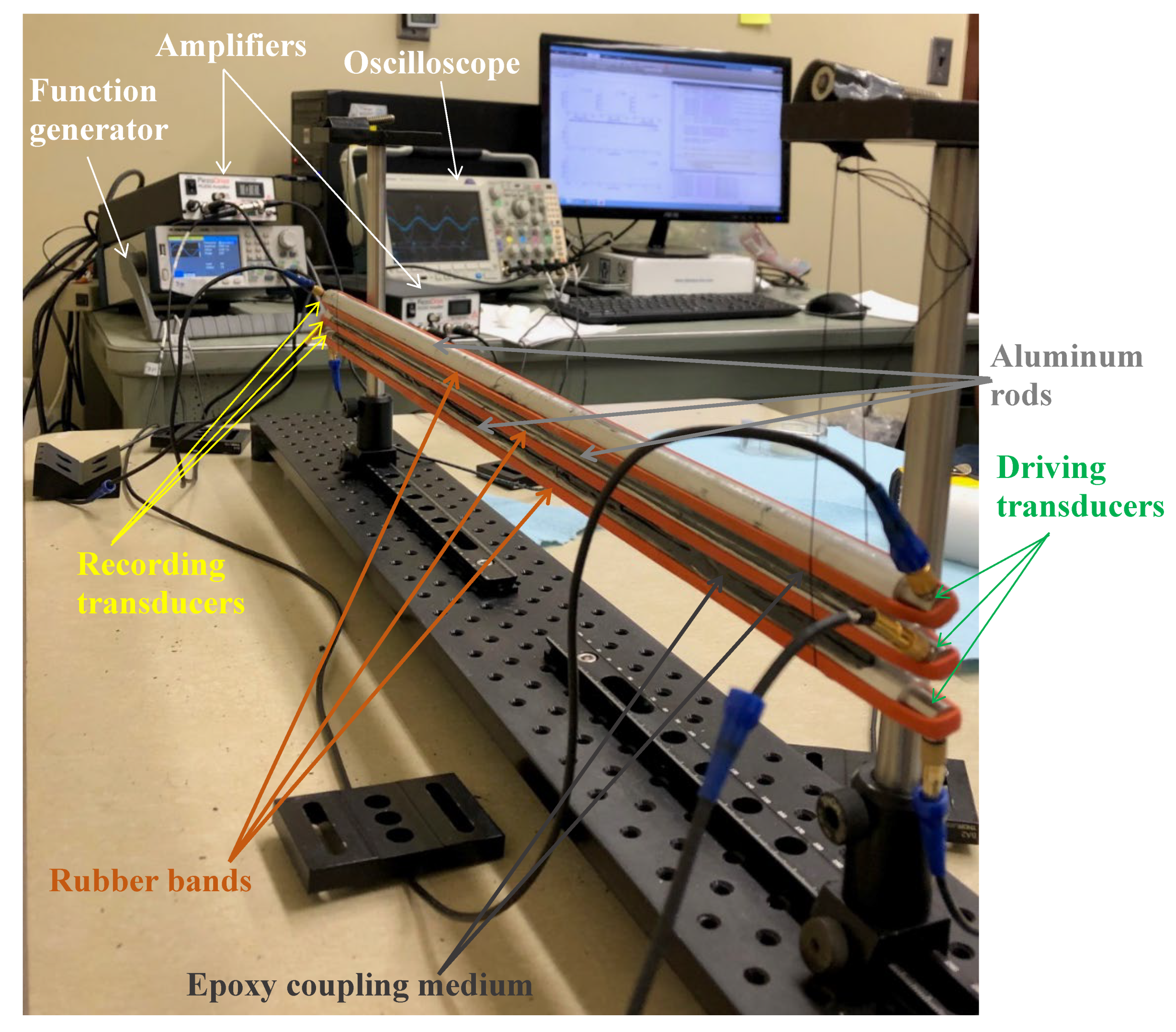
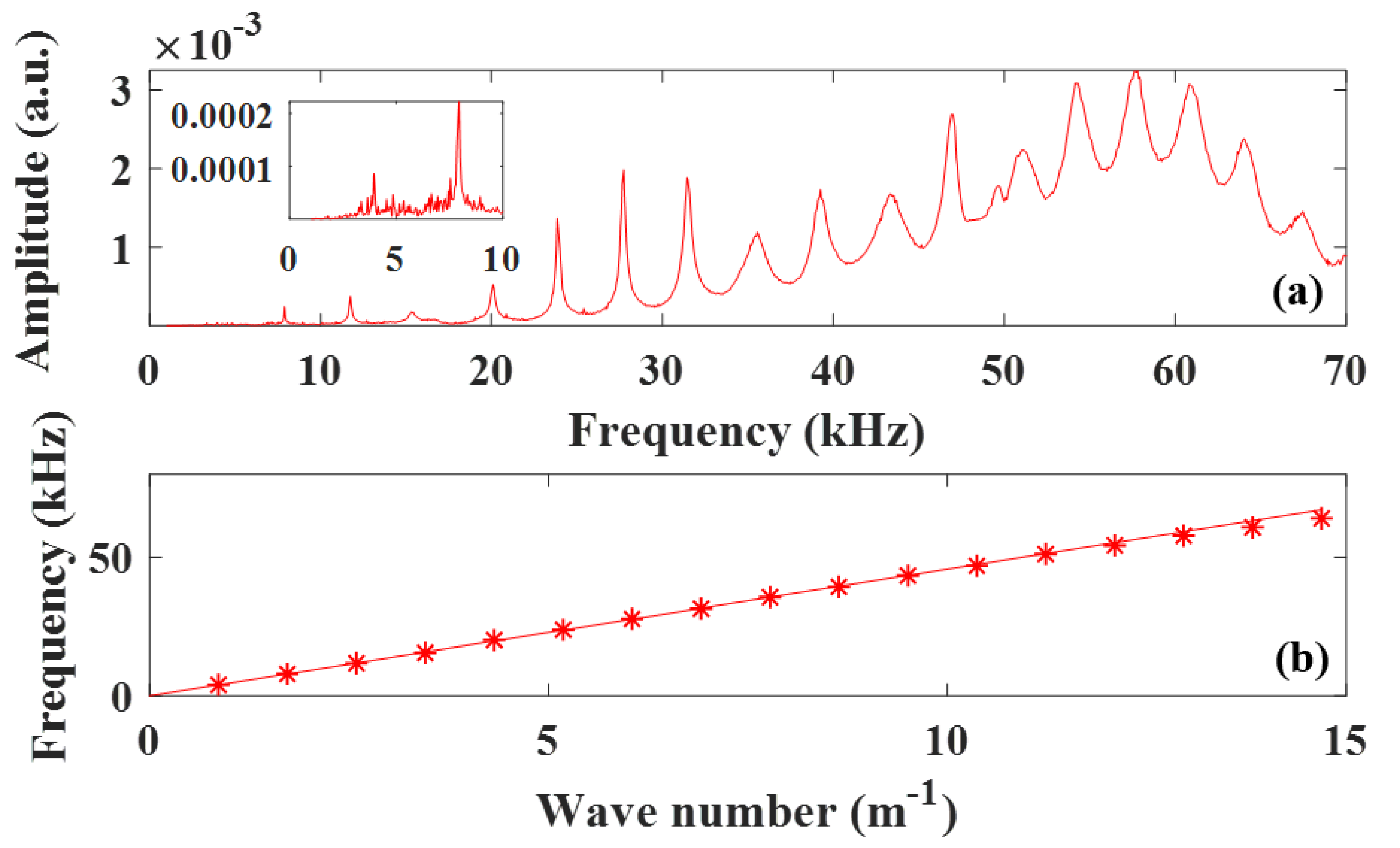


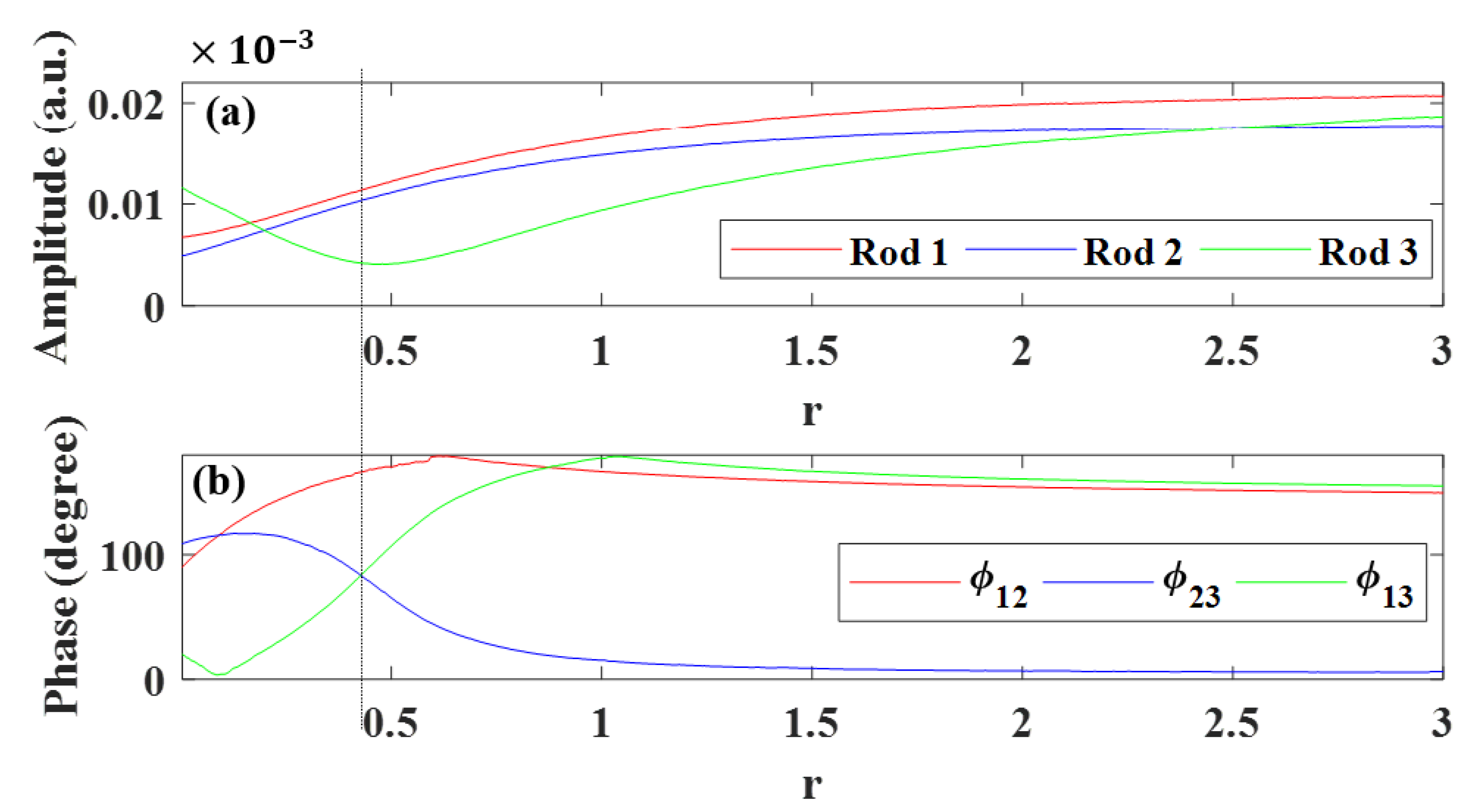
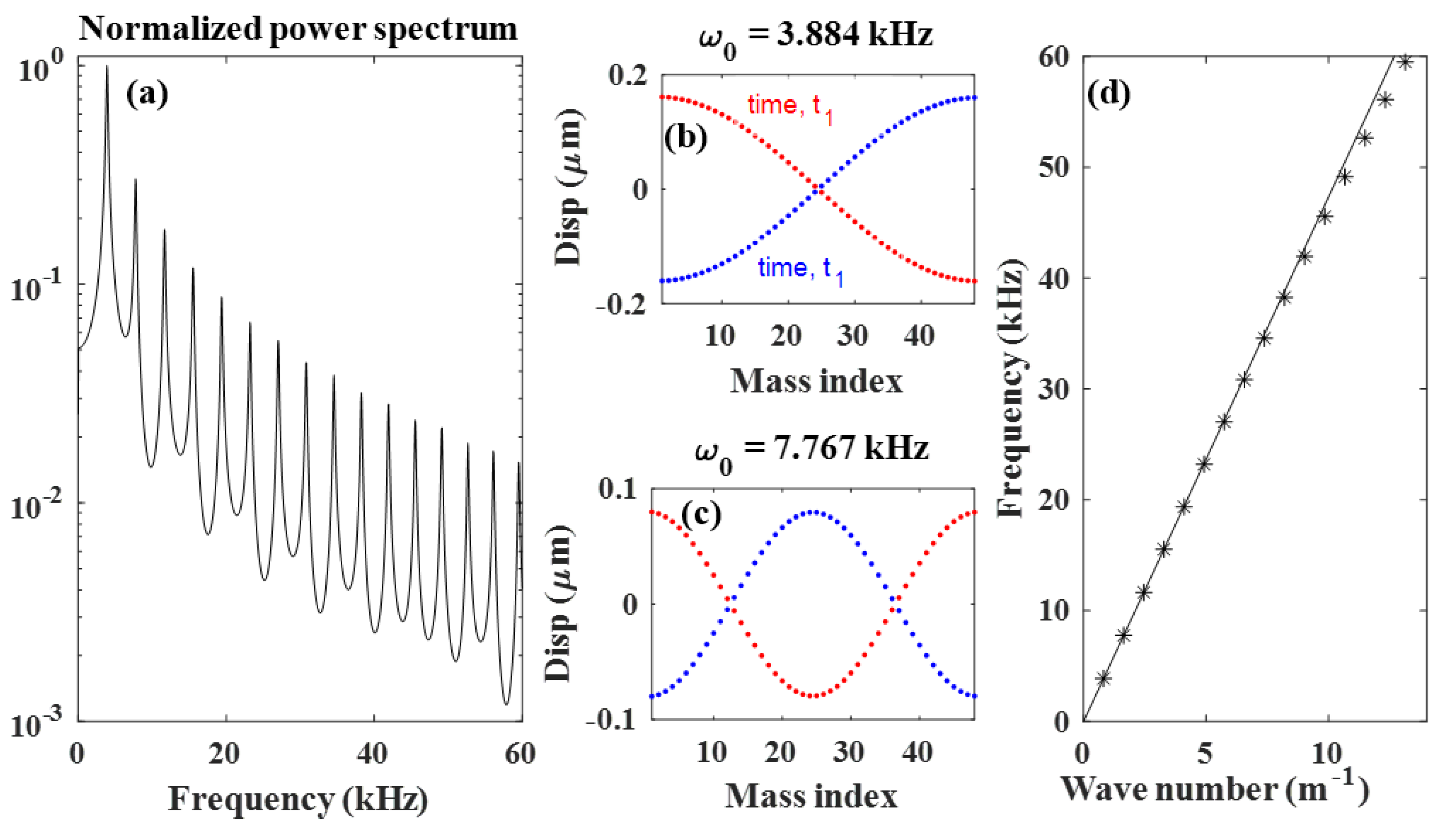

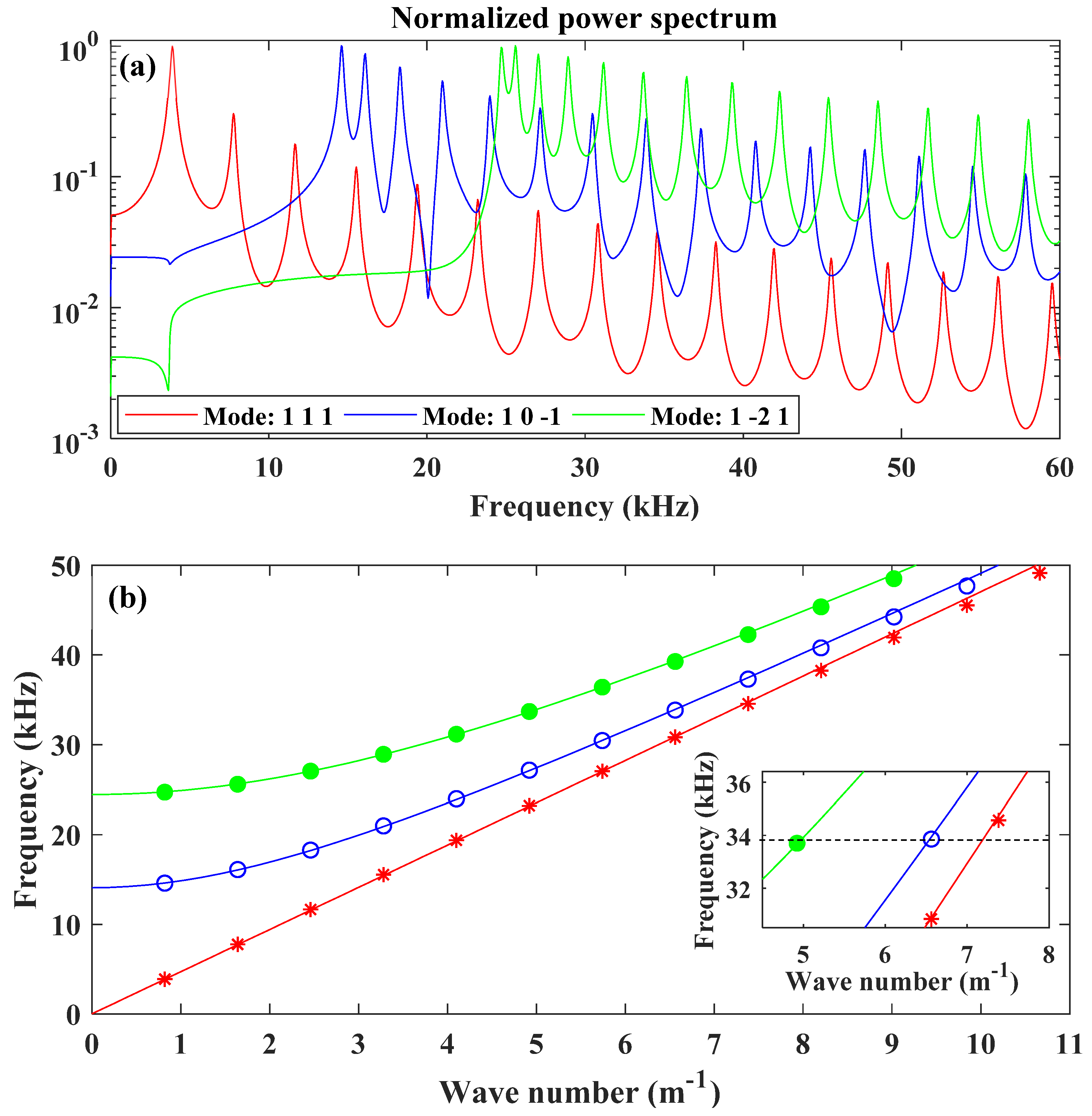
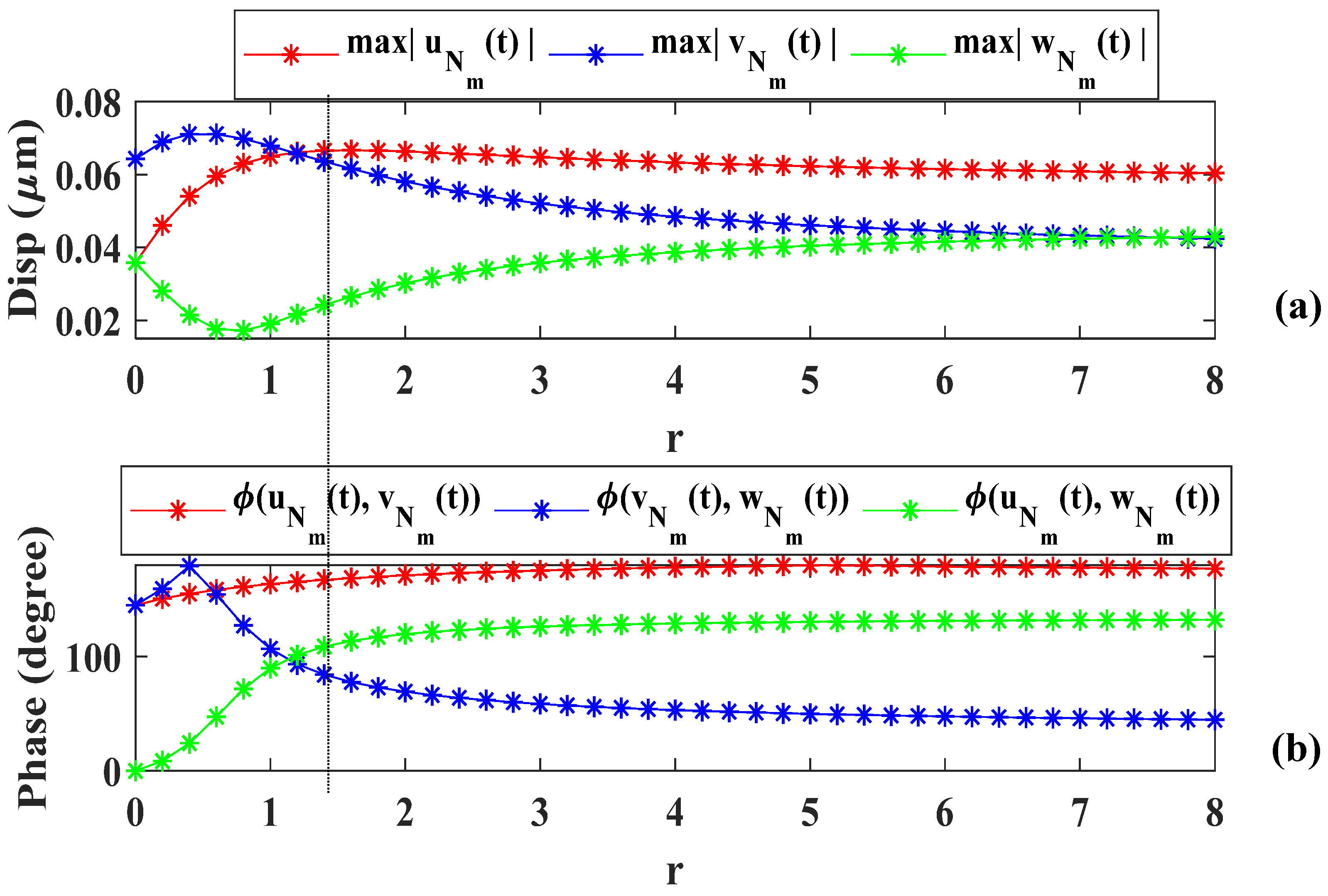
© 2020 by the authors. Licensee MDPI, Basel, Switzerland. This article is an open access article distributed under the terms and conditions of the Creative Commons Attribution (CC BY) license (http://creativecommons.org/licenses/by/4.0/).
Share and Cite
Hasan, M.A.; Calderin, L.; Lata, T.; Lucas, P.; Runge, K.; Deymier, P.A. Directional Elastic Pseudospin and Nonseparability of Directional and Spatial Degrees of Freedom in Parallel Arrays of Coupled Waveguides. Appl. Sci. 2020, 10, 3202. https://doi.org/10.3390/app10093202
Hasan MA, Calderin L, Lata T, Lucas P, Runge K, Deymier PA. Directional Elastic Pseudospin and Nonseparability of Directional and Spatial Degrees of Freedom in Parallel Arrays of Coupled Waveguides. Applied Sciences. 2020; 10(9):3202. https://doi.org/10.3390/app10093202
Chicago/Turabian StyleHasan, M. Arif, Lazaro Calderin, Trevor Lata, Pierre Lucas, Keith Runge, and Pierre A. Deymier. 2020. "Directional Elastic Pseudospin and Nonseparability of Directional and Spatial Degrees of Freedom in Parallel Arrays of Coupled Waveguides" Applied Sciences 10, no. 9: 3202. https://doi.org/10.3390/app10093202
APA StyleHasan, M. A., Calderin, L., Lata, T., Lucas, P., Runge, K., & Deymier, P. A. (2020). Directional Elastic Pseudospin and Nonseparability of Directional and Spatial Degrees of Freedom in Parallel Arrays of Coupled Waveguides. Applied Sciences, 10(9), 3202. https://doi.org/10.3390/app10093202



